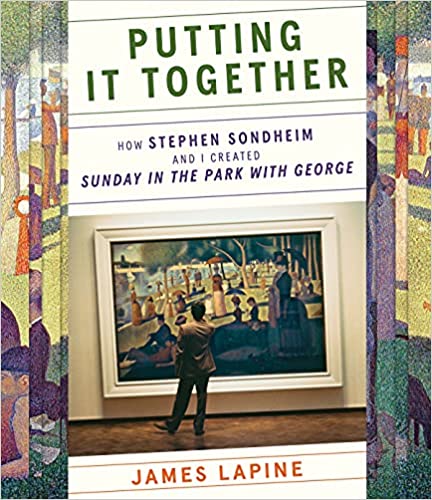Books |
Putting It Together: How Stephen Sondheim and I Created “Sunday in the Park with George”
James Lapine
By
Published: Aug 03, 2021
Category:
Theater
In 1982, when James Lapine met Stephen Sondheim, Sondheim was a theater icon. His credits included “West Side Story,” “Gypsy,” “Company,” “Follies,” “A Little Night Music,” “Pacific Overtures” and “Sweeney Todd.” But in 1981 he wrote a play that closed after 16 performances, and he was thinking of quitting the theater and designing video games. Lapine was his polar opposite, a new kid on the block: one unlikely show about Gertrude Stein that won him an award, followed by an even more unlikely show based on a Jungian case history, and then “March of the Falsettos,” a hit.
In the living room of his Manhattan townhouse, Sondheim lit a joint and passed it to his young visitor. Forty years later, he recalled that moment in a conversation for “Putting It Together: How Stephen Sondheim and I Created ‘Sunday in the Park with George,” Lapine’s book about the making of the musical they created together: “I just figured that anybody of your generation smoked dope all the time, which was true.”
Forty years after the opening of “Sunday in the Park with George,” Lapine adapted the greatest Broadway memoir ever written — Act One, by Moss Hart. It was, in so many ways, the same story as his collaboration with Sondheim. A talented young man meets a Broadway legend. They collaborate. It’s a hard road to opening night, but when it comes and the applause ends, the legend delivers a line that launches his protégé. As I say, “Act One” stands alone — until now. [To buy the book of “Putting It Together” from Amazon, click here. For the Kindle edition, click here.]
In 2017, two years after he adapts “Act One,” Lapine is watching a revival of “Sunday in the Park” when “a voice in my head” asks some questions: Who wrote this? How did they write it? That led to interviews and conversations with 40 people, almost everyone involved in the production. The book is chronological, which is both its strength and its drama — if you didn’t know the happy ending, you’d say this is the story of a disaster-in-the-making.
Of course it starts well. Lapine shows Sondheim a postcard of the Seurat painting. “Who’s missing?” he asks. “The artist.” With that, they have the story of the first act.
But they’re short on songs. Sondheim suggests, “Why not just do it as a play. No songs.” In the next breath: “Despite all that, I couldn’t wait for people to know we were doing this.”
Personalities clash. “I just felt you hated me, or were taking out whatever frustration you were feeling on me,” Lapine confides to Patinkin. “And I can’t say that I was wildly fond of you.” Patinkin, who has never been described as laid back, threatens to quit. His wife advises Lapine, “Just tell him you love him.”
There is a first act, but not a second. And then there is a second act. But there are no songs. Sondheim tells Lapine this is not exceptional. Sondheim: “My procrastination is built in.” Patinkin is taken by surprise. A week before opening night, he grabs Sondheim by the shoulders: “Write me anything! Even if it’s a piece of shit. We don’t care! Give us something.”
The pre-opening mood is glum. The cast retitles the show: “Sunday in the Dark and Bored.” The stage manager increases the volume on the stage microphones so the actors will think the applause is louder. Before opening night, Lapine’s speech to the actors sounds like a plea: “Trust the show. Please believe in what we’ve made.” Two months later, Sondheim will have a heart attack.
And yet, out of this disruption and uncertainty comes, in Lapine’s words. “a work of art based on a work of art.” Just so. For “Sunday in the Park with George,” Lapine won the 1985 Pulitzer Prize for Drama. The show won two Tony Awards for design and a nomination for Best Musical. This overwhelming critical succes ran for 604 performances — and lost money.
If you love theater, especially musical theater, this is required reading.


